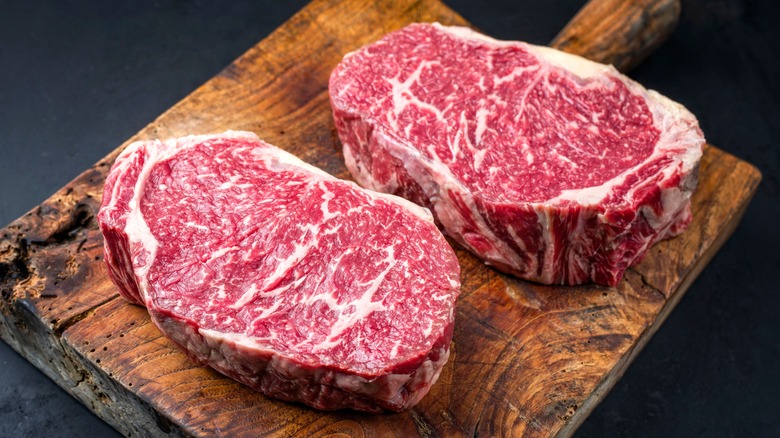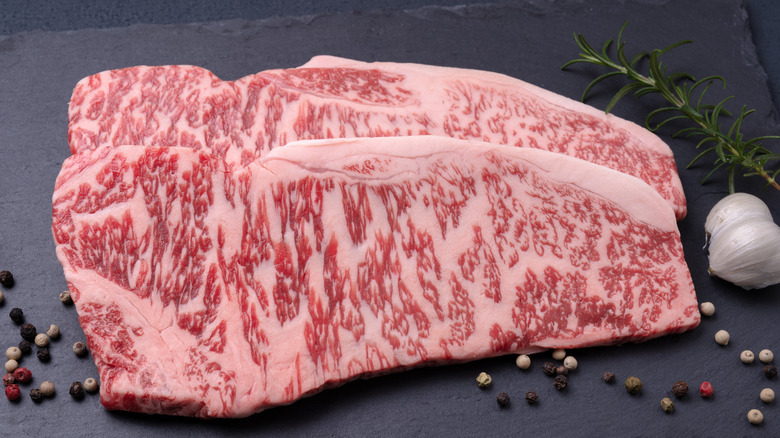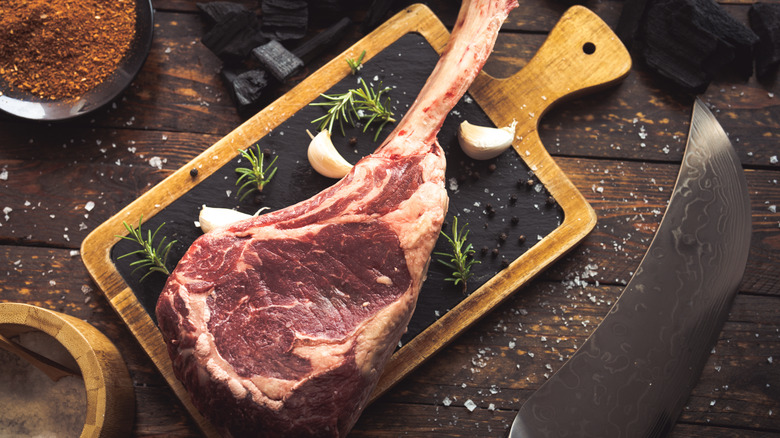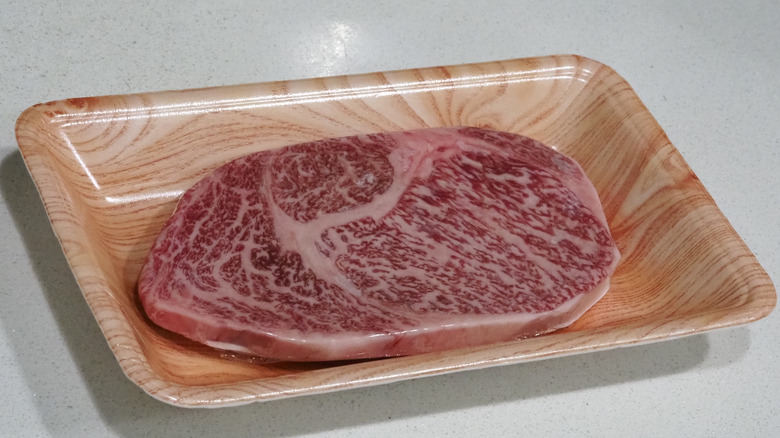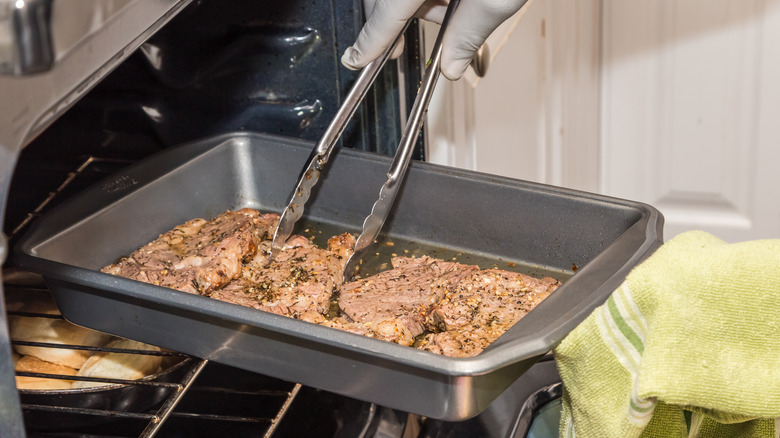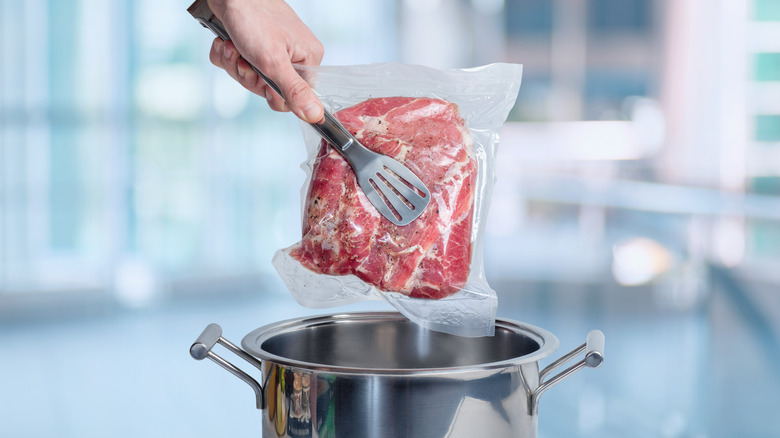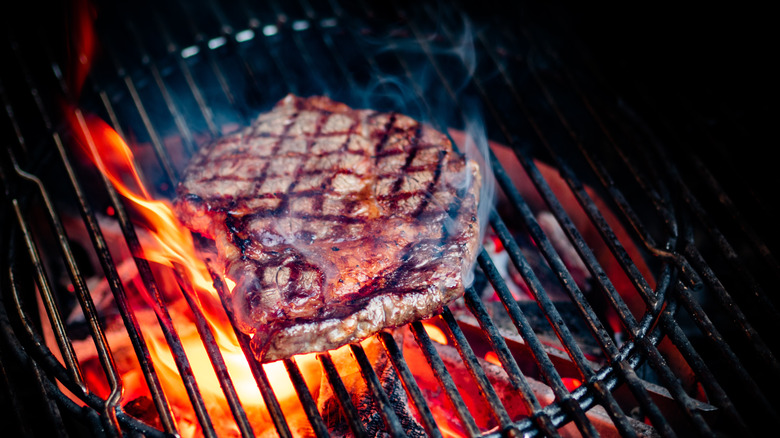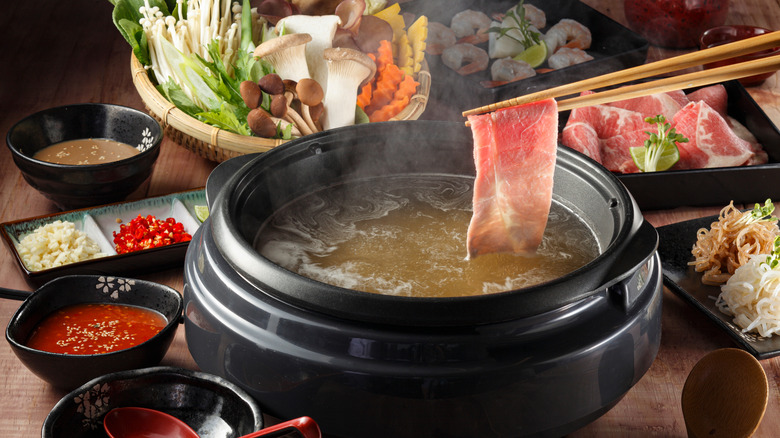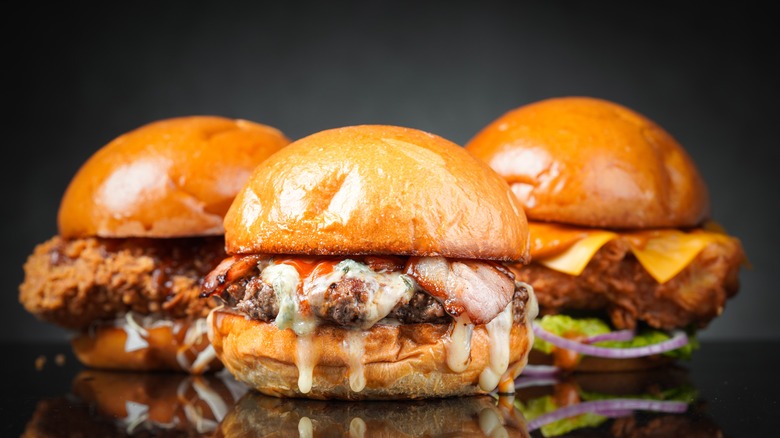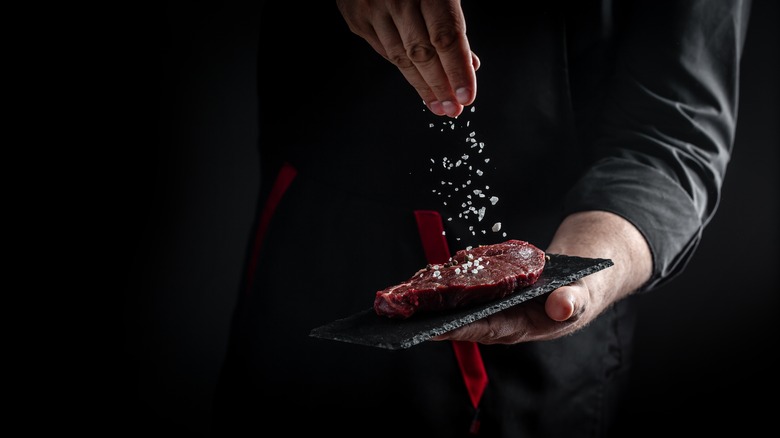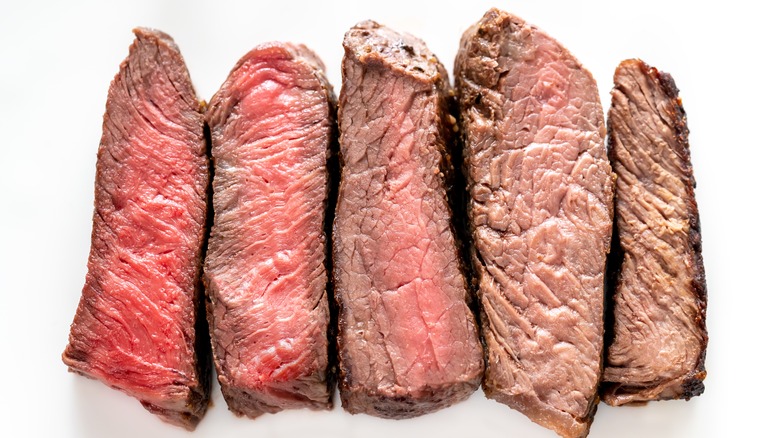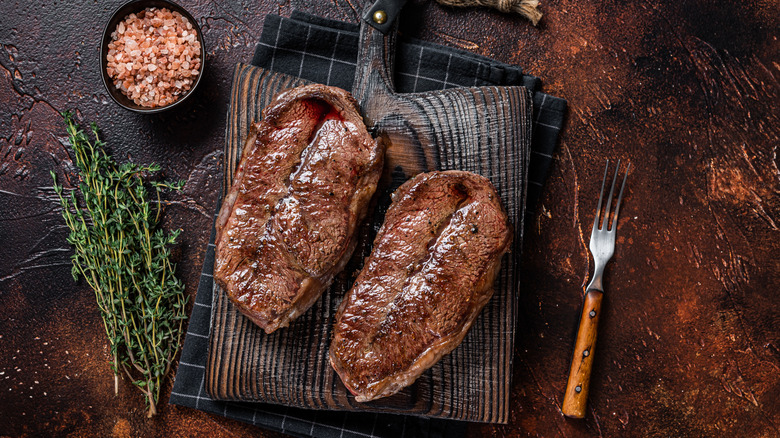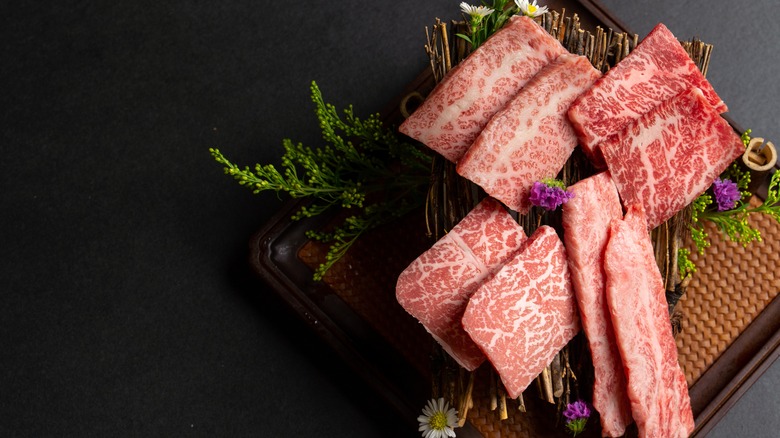Mistakes Everyone Makes Cooking Wagyu Beef At Home
Wagyu beef is all over restaurant menus these days, often with a very hefty price tag attached. And that's understandable! Wagyu beef may very well be the best beef in the world. With just one bite, you'll see this is far from hyperbolic. Originally hailing from Japan, the cattle destined to become Wagyu beef are traditionally raised in a low-stress environment and fed high-grade feed to encourage the development of an ultra-marbled, super-flavorful finished product. Within the greater category of Wagyu beef, there are multiple grades corresponding to standards of color, texture, marbling, firmness, and fat content. A4 and A5 beef are the crème de la crème.
Beef this good deserves to be cooked to perfection. You don't want to just slap a chunk of Wagyu beef on the grill and call it a day — it's an insult to your wallet and the meat itself. Yet many people do fail to treat their Wagyu beef the way they should. Given its luxe appeal and the relative inexpensiveness of sourcing this beef directly from the butcher, rather than at a steakhouse, this is an understandable mistake to make. The notion of cooking Wagyu at home is just too good to resist. But there are a few things to bear in mind before heating up the grill. Here are some of the biggest mistakes home cooks make when cooking Wagyu.
Misunderstanding the differences between American and Japanese Wagyu
The first thing to bear in mind when cooking Wagyu at home is that not all Wagyu is alike. While Wagyu originally hails from Japan, some Japanese Black and Brown cows were imported to the U.S. between 1975 and 1997. While the breeds do exist here, methods of raising and grading these cattle vary widely from country to country. The resulting beef offers very different flavor and textural profiles you'd do well to take into account.
While Japanese Wagyu is made with 100% Wagyu cattle raised in Kobe, American Wagyu comes from hybrid cattle: a cross between Wagyu and Angus, or another high-quality breed. As a result, Japanese Wagyu is much tenderer, richer, and more intensely marbled than American Wagyu, which has a beefier flavor. As Dave Yasuda of Snake River Farms told InsideHook, American Wagyu combines the best of both varieties, marrying the richness of Wagyu with the meaty flavor Americans love. He remarked, "People understand the delicious difference of American Wagyu beef as soon as they take their first bite."
This difference means that cooking approaches should vary depending on which Wagyu you've actually got your hands on. Rich Japanese Wagyu is usually cooked and served in smaller portions and thinner slices, and it's typically poached or quickly grilled. American Wagyu, meanwhile, can stand up to approaches typical of other top-quality steaks, like pan searing, sous-vide cooking, or even grilling.
Not seeking out the dry-aged stuff
If you want truly bonkers flavor, you should go one step further than simply seeking out the best Wagyu — you should shell out for the dry-aged stuff. Dry-aging involves hanging fresh meat in a temperature-controlled room to encourage very particular enzyme breakdown and oxidation. This leads to incredibly tender and flavorful steaks.
Chefs like Nate Green of Hong Kong's Rosewood Hotel choose to dry-age Wagyu before using it in dishes like steak tartare, where the flavor of the beef is the focus of the dish. Richard Ekkebus of Hong Kong's Amber restaurant dry-ages his Wagyu strip loin for a whopping 147 days, using the Wagyu fat to season the kabocha purée that accompanies it for even deeper umami flavor.
While you might be able to track down dry-aged Wagyu at your local butcher shop, another option is to dry-age your Wagyu at home. All you need is to stick the beef on a wire rack over a sheet pan in the fridge, seasoning with salt if you want to encourage even more moisture to leave the steak. It might not give you exactly the same effect as a professional dry-aging room, but it'll be a whole lot less expensive. Seeing as high-grade Wagyu can cost over $200 a pound, a little bit of trimming goes a long way.
Cooking Wagyu straight out of the fridge
Once you've sourced your beef, it's time to get cooking. The secret to cooking excellent Wagyu is, as with many kitchen tasks, patience and planning. Specifically, you're not going to want to take a cold Wagyu steak out of the fridge and slam it into the pan. Cooking steak right out of the fridge often leads to an uneven temperature; the outside gets overcooked while the inside stays cold and rare. To reduce unevenness in cooking, most experts recommend removing Wagyu from the fridge an hour before cooking, to bring it to room temperature.
That said, we have a word of warning: While this advice holds true for American Wagyu, when it comes to the top-grade Japanese stuff, you should do the exact opposite and employ the technique known as cold searing. Cold searing means the cold steak starts in a cold skillet, which minimizes fat splatter and ensures that most of the fat remains in the beef, rather than rendering out of it, as it might if you brought the steak to room temperature. What fat does render out into the pan doubles as cooking fat, so the steak essentially fries in its own tallow.
Reverse searing your steak
Kitchen lore has long dictated that steak should be cooked at a very high temperature first, then finished in the oven for an even temperature throughout. But new culinary wisdom has brought about the advent of the reverse sear. These days, many home cooks take it as gospel. Reverse-searing involves starting your steaks in a low oven, to cook them through. Then they get a final sear in a ripping hot skillet for a lovely char on the outside.
Reverse searing can be a good idea with Wagyu ... but it isn't always the best option. The discrepancy comes down to that all-important distinction between American and Japanese Wagyu. American Wagyu steaks, with their minimal marbling and consequential thickness, can indeed take the heat of this method. It eliminates the guesswork of knowing when your steak is done, as a probe thermometer can help you keep an eye on it as it slowly comes up to temp in the oven. But when it comes to Japanese Wagyu, the experts agree: Avoid reverse-searing. The thinner steaks are liable to overcook before they ever build up a nice crust.
Cooking Wagyu sous-vide
Sous-vide cooking is yet another modern trend in cooking steaks that many home cooks have embraced. The idea is similar to reverse-searing: The steak is vacuum-sealed in a plastic pouch (sous-vide, in French) then submerged in a water bath whose temperature is precisely controlled. The result is an evenly-cooked interior and an exterior just waiting to be seared in a hot pan.
Sous-vide offers the same benefits as reverse-searing: more control and more even cooking. But it also introduces some of the same problems. As with reverse-searing, American Wagyu can indeed stand up to this method, which creates deeper flavor and keeps the meat juicy and moist. Given the high fat content of Japanese Wagyu, however, using this method with such top-quality steaks is contingent on one caveat. While experts note that unlike with reverse-searing, sous-vide can be appropriate for cooking Japanese Wagyu, it's imperative to waste no time between cooking it sous-vide and finishing it off with that final sear. Otherwise, the fat will continue rendering from the meat while you wait, leaving you with a steak that is at once fatty and dry.
Grilling Wagyu directly over the flame
There is perhaps no method for cooking steaks more delicious than grilling. But when it comes to Wagyu, this approach may well be a recipe for disaster. After all, the very fattiness that makes Wagyu so craveable can quickly become its downfall when you consider just how flammable all that fat is. As the fat renders out of the cooking steak, it may drip down onto the coals, proving painful in more ways than one. Not only is that flavorful fat going to waste, it also runs the risk of creating flare-ups that could singe or burn your delicate steak (not to mention your eyebrows).
For this reason, many experts recommend that if you're grilling Wagyu, you do so in a cast iron pan, which keeps all that fat contained. The benefits are twofold: Not only does this method minimize the chance of flare-ups, it also allows the beef to cook in that flavorful rendered fat, ensuring you never end up with a dry Wagyu steak. Moreover, moving the pan off the range and onto the grill keeps the grease out of your kitchen, for much simpler post-dinner clean-up.
Forgetting about shabu shabu
In Japan, Wagyu is often poached, rather than being pan-seared or grilled, as many Westerners expect. Shabu shabu is a traditional hot pot-style dish where meat and vegetables are cooked directly at the table by diners in a deliciously complex broth, then dipped into homemade sauces. Typically, you would dip the beef and mushrooms into a sesame-based sauce and everything else into a ponzu sauce, though with Wagyu, you may want to forego the sauce and enjoy it all on its own. Much like fondue, this convivial approach to enjoying Wagyu is fun and delicious. Once you've armed yourself with the right cooking vessel, it's an easy, creative choice for your next dinner party.
When making shabu shabu at home, you'll want to source extremely thinly cut Wagyu, so that it cooks through quickly in the broth and is easy to eat in one bite. You should be able to find these thin slices of Wagyu at a large Asian grocery store, but if you don't have one near you, ask your butcher to slice the beef as thinly as possible. It's usually accompanied by vegetables and tofu, which bulk out the meal and mean that you can offer just an ounce or two of the expensive Wagyu to each of your guests. If you want to cut costs even more, you could also serve a bit of thinly sliced pork belly in addition to the beef.
Wasting Wagyu by putting it in burgers
Luxe burgers are everywhere these days, topped with everything from truffles to caviar. When one of these high-class burgers has a price tag in the four digits, you can be pretty sure that patty is made with Wagyu. Just look at Las Vegas' aptly named 777 Burger, which does indeed cost $777, or the $6,000 Golden Boy from the Netherlands. But the reality is, this opulent approach to burgers is more gimmick than anything else. At the end of the day, using Wagyu beef in burgers is a waste of excellent beef. After all, it's the marbling that makes Wagyu so delicious and tender; when you grind it into mince, you're totally missing the point.
The one exception, according to butcher Walter Apfelbaum, is when you have offcuts and trim. These, he says, make perfect one-bite sliders. "It's so fatty and so rich that, personally, I don't want that as a burger," he tells Food & Wine. "I don't want to be taking these huge bites of that. It's too much." If you don't want to make sliders with these offcuts, Wagyu trimmings can also be used to add richness to leaner beef, reducing waste and upping the fat content of your burger for a best-of-both-worlds sandwich that's luxurious, flavorful, and far less onerous than one made exclusively with top-notch Wagyu.
Over-seasoning Wagyu
It's a shame to over-season any top-quality steak; after all, the meat should really be what's doing the talking. But that holds double when it comes to Wagyu, which is delicious even when seasoned solely with kosher salt before cooking and finished with a top-quality flaky sea salt or fleur de sel. You could also add black pepper, though experts note you should go easy on this staple, which can actually make the steak bitter as it cooks, particularly at the high heat required to get the perfect sear. Garnish your finished Wagyu, if you must, with some fresh herbs. Keep the steak seasoning blends, steak sauces, and ketchup in the cupboard where they belong, and save your bearnaise, au poivre, and blue cheese sauces for steaks that need the extra help. The best Wagyu has all the flavor it needs built in.
Over-cooking Wagyu
Over-cooking steak is a no-no whether you're working with Wagyu or not, but it holds double when we're talking about this luxuriously marbled cut. Most experts prefer to cook Wagyu to medium-rare or even medium, when the interior is still pink and soft, but hot all the way through. This temperature brings out the tender texture of Wagyu, ensuring that it remains juicy and that the fat is rendered throughout.
Depending on the thickness of the steak, you could be looking at cooking Wagyu anywhere from seven minutes to just two. If you want to make sure you're getting it just right, you may want to invest in a kitchen thermometer — you're looking for somewhere between 129 ºF and 144 ºF internal temp, depending on which side of rare you prefer. Either way, don't fear that old legend about probe thermometers drying out your meat: The juice loss is negligible and far less detrimental than over-cooking your steak.
Forgetting to rest your cooked Wagyu
Wagyu cooking guides often suggest you shoot for a slightly lower internal temperature than the one you ultimately hope to reach, as Wagyu, like all meat, continues to cook once it's removed from the pan. To make sure that you don't accidentally overcook your Wagyu, take it off the heat (or out of the oven) when it's about 5 ºF shy of the desired final internal temperature. Then you should set the steak aside in a warm place, covered, to rest. Don't worry — you won't need to wait too long! For a steak, you're looking at about five minutes, which should be just enough time to allow the juices to redistribute and the steak to finish cooking gently until it reaches medium-rare perfection. This also allows the lovely aromas to permeate your kitchen, ensuring that eager diners are totally tantalized in the minutes leading up to slicing and serving.
Making too much Wagyu
Given how delicious and luxurious Wagyu is, it can be tempting to make the most of your investment, serving a similar portion size as you would with other top-quality beef. Luckily for your bank account, that's far from necessary — nor, for that matter, is it the most pleasant way to enjoy this well-marbled cut. Given the richness of true Japanese Wagyu, you'll want to keep portions pretty small: For the top-notch Japanese A5 Wagyu, an ounce or two per person is more than enough. Any more than that, and you run the risk of not appreciating the delicacy of the beef, or becoming overwhelmed by its fattiness. Choose a neutral, lighter side with a bit of freshness and crunch to complement the tender beef — think tender-crisp green beans or sautéed asparagus — and you'll turn the morsels of meat into a complete meal.
If, on the other hand, you're going for the slightly less marbled American Wagyu, you can scale up slightly, though you still won't want to serve massive portions. Roughly 12 to 16 ounces of the slightly less rich American Wagyu is more than enough for two people.
